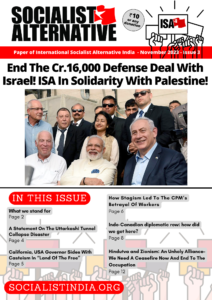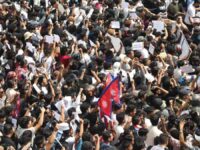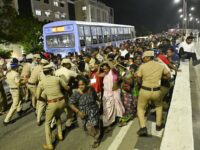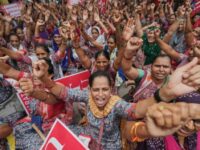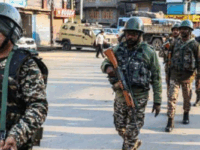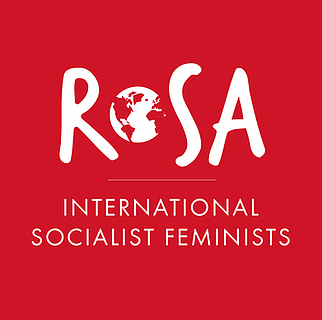Pahalgam killings: as Kashmir bleeds again, India and Pakistan fan the flames of war
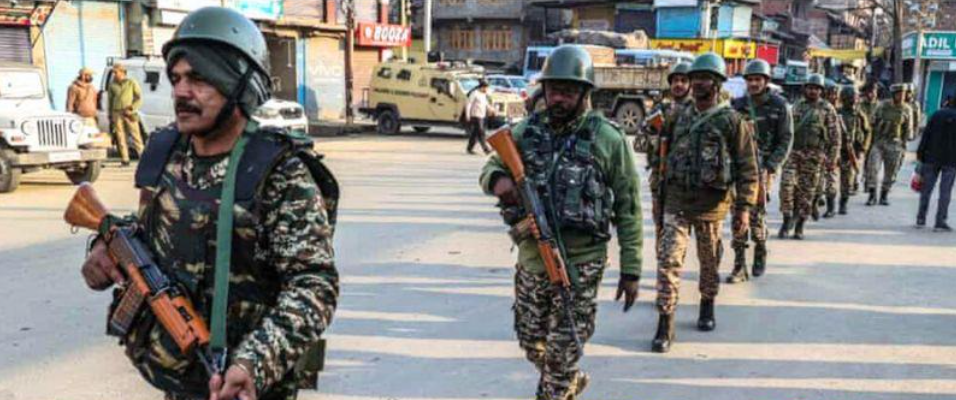
The Indian subcontinent once again stands on the brink of catastrophe. With the Pakistani military alleging “credible intelligence” of imminent Indian airstrikes, the prospect of last week’s terror attack in Indian-occupied Kashmir becoming the spark of a new military conflict between the two nuclear-armed states is no longer distant — it is a live and looming threat. Below, we present our analysis and response to the events that have shaken the region over the past week.
Socialist Struggle India
On April 22, twenty-six civilians were massacred in a terrorist attack in Pahalgam, a hill-station resort in the Baisaran Valley, Indian-occupied Kashmir. All but one of the victims were Hindu, and according to eyewitness accounts, they were singled out and targeted for their religion. Twenty-four were Indian tourists and one a Nepalese national. One Kashmiri Muslim, a young local pony guide, was also killed while trying to protect tourists from being shot.
The killings sent shockwaves through the region. In response, widespread protests and vigils broke out across Jammu, Kashmir, and Ladakh to denounce the massacre and express solidarity with the victims, and a complete bandh was observed on Wednesday — the first time Indian-occupied Kashmir came to a standstill in 35 years.
The immediate casualties are not limited to the tragic loss of life and the many others injured. For the hundreds of thousands of Kashmiris who depend on tourism for their livelihoods, the situation is dire. With tourists fleeing the region, once-bustling areas like Pahalgam have been left abandoned just as the peak season was about to begin, exacerbating the already heavy burden on local communities.
Yet tourism in Kashmir is not merely an economic activity; for Narendra Modi’s regime, it is also a propaganda instrument used to obscure and normalise the occupation. The Indian government has systematically weaponised the flow of tourists to showcase an image of ‘integration’ under Indian rule, and to portray the region as a tranquil destination while brutal repression continues in the background. High-profile tourism campaigns and record visitor numbers have been used to bolster claims that the region had stabilised, even as it remains under military lockdown and Kashmiris themselves are denied the most basic democratic rights. As the recent attack tragically underscored, this attempt to use tourists as symbols of success is not only deceptive — it is also dangerous.
Exploiting bloodshed for chauvinist gains
The exact identity of the perpetrators remains unclear. Initial reports linked the gunmen to ‘The Resistance Front’ (TRF), a shadow organisation and offshoot of Pakistan-based Lashkar-e-Taiba. However, after initially purportedly admitting responsibility for the attack, the group has since denied any involvement, issuing a statement claiming that “any attribution of this act to TRF is false, hasty, and part of an orchestrated campaign to malign the Kashmiri resistance.”
Regardless of the truth, Modi’s Hindu supremacist regime wasted no time to politically exploit the attack, and to try and twist people’s understandable outrage at the brutal killings into something more sinister. Modi himself skipped an all-party meeting on Thursday discussing the Pahalgam attack, opting instead for posturing at an election rally in Bihar where he vowed to pursue the Pahalgam attackers “to the ends of the Earth”.
The corporate media and government representatives have launched a festival of jingoism and hyper-nationalist chest-thumping. Commerce Minister Piyush Goyal declared, “Until 140 crore Indians don’t make nationalism and patriotism their supreme duty, these types of incidents will continue to trouble the country”, making a parallel between the elimination of terrorism and the elimination of Naxalism —a term which, under the ruling BJP, has often been weaponised to brand not just armed insurgents but anyone critical of the state.
Blaming the attack on the lack of patriotism of ordinary Indians is alo a cynical attempt to turn the heat away from the government’s own failures. The BJP’s abrogation of Article 370 in 2019 —unilaterally stripping Kashmir of its constitutional autonomy— had been sold by Modi’s government as a means to bring development, peace and stability to the region. For the past five years, the government peddled a ‘normalcy’ narrative, pretending that its policies were transforming Kashmir into a terror-free haven for tourists. Last Tuesday’s events —the deadliest attack on tourists in a quarter of a century— have exposed the complete hollowness of this narrative.
Occupation and lack of alternative breed despair
To truly understand the tragedy in Pahalgam, one must reckon with the unresolved national question in Kashmir —a region whose people have been denied their basic democratic right to self-determination for 78 years.
In 1947, the princely state of Jammu & Kashmir was forcibly absorbed into India, after an armed tribal invasion backed by Pakistan prompted the Maharaja to sign the Instrument of Accession to India. This decision was made without any democratic consultation of the Kashmiri people — it was a deal between elites, struck in the midst of violent partition. The Indian government promised that a plebiscite would be held to allow the people of Kashmir to freely decide their future. That vote never took place.
Instead, successive Indian governments have entrenched their rule through military control and repression. Over the last 35 years —since the outbreak of a mass insurgency in 1989— this has been characterised by an unrelenting regime of outright military occupation, emergency laws, and systemic state violence. Kashmiris have endured decades of arbitrary arrests, extrajudicial killings and disappearances, sexual violence by security forces, rigged elections and broken promises. The abrogation of Article 370 further intensified the sense of subjugation, choking off even the limited space for political expression that once existed.
Claims that thanks to the scrapping of Jammu and Kashmir’s special status, the region was on a renewed path to economic prosperity are equally fraudulent. Whereas before 2019, its overall unemployment rate was below the national average, it has been consistently above the national average ever since. All other economic indicators (debt levels, growth rates, inflation etc) have also gotten worse.
While the killing of unarmed civilians is utterly reprehensible, it did not occur in a vacuum. The Indian state’s brutal occupation, the refusal by all mainstream parties to recognise the legitimacy of the Kashmiris’ long standing demands for justice and freedom —including the Left parties like the CPI and CPI(M), who have long pandered to Indian nationalism—, the decades of betrayal and humiliation, the alarming levels of youth unemployment, have together created a cocktail of conditions in which despair, alienation and violent currents can take root.
Yet the targeting of Hindu civilians —especially under a government steeped in Hindutva ideology— does not challenge these conditions in any way; on the contrary, it aliments revengeful communal attacks on Muslims across India, and plays directly into the hands of Modi’s regime, giving it a pretext to intensify repression and bring the subcontinent closer to a catastrophic war.
Crackdown in Kashmir
Since the attack, a sweeping State crackdown has been underway in Indian-occupied Kashmir. The Indian army has expanded its presence in what is already the most militarized region on the planet. More than 600 locations in the Valley have been raided in less than a week, and more than 1,500 Kashmiris have been arrested. Without any due process, at least nine houses of suspected militants allegedly involved in the attack have been demolished by explosives, damaging many surrounding houses in the process and making entire families suffer for the actions of a few.
The government has also issued an advisory urging media channels to refrain from live coverage of ‘defence’ operations —a hardly veiled form of censorship, that gives the Modi regime greater leeway to control the narrative and cover for human rights abuses, in a region where the Indian army has a long and entrenched legacy of such violations.
The government’s response to the Pahalgam killings is exacerbating the very conditions that gave rise to such terrorist violence in the first place. The violent repression by the Indian armed forces is indeed not merely a backdrop to these attacks —it is a direct contributor. Every military raid, every arbitrary detention, every act of impunity feeds into a climate of hopelessness and rage. For countless young people growing up under constant siege, without jobs, freedom, or a political future, violent resistance —however desperate and destructive— can appear as and is often the only form of agency left.
Tensions with Pakistan escalate
Union Home Minister Amit Shah —the same Shah who only weeks earlier, boasted in Srinagar that “the entire terror ecosystem” in Jammu and Kashmir had been “crippled”— immediately went to Pahalgam to visit the site of the attack. In the aftermath, he instructed the chief ministers of all Indian states to identify all Pakistani citizens in their jurisdiction, cancel their visas and send them back.
Though cross-border involvement has a long history, Modi’s regime was quick to pin the blame on Pakistan for the attack without presenting so far a shred of evidence, launching a raft of retaliatory measures targeting not just Pakistani officials, but ordinary Pakistanis as well. Even Pakistani nationals on medical visas have been told to leave the country within days.
India has also decided to suspend the Indus Water Treaty, signed in 1960, which is critical to Pakistan’s agriculture and hydropower generation. Open threats have been uttered that “not a drop of water” would go to Pakistan anymore. While the notion that India could block all water flows to Pakistan is unrealistic, the ramifications of such threats carry real and dangerous consequences, as this treaty withstood several full-scale wars and crises between the two countries. As a matter of fact, the Pakistani government said it considered such a move tantamount to an “act of war”, and suspended all bilateral agreements, including the 1972 Shimla Agreement (a treaty committing both sides to resolve their disputes through peaceful means) in response.
Over recent days, repeated exchanges of gunfire and artillery have occurred between the two sides along the Line of Control, which separates the Indian from the Pakistani-controlled parts of Kashmir, against the background of increasingly bellicose statements and counter-statements —including Pakistan Railway Minister Hanif Abassi threatening India with nuclear retaliation, stating that 130 nuclear missiles were targeted at India. Both countries have also suspended cross-border trade and carried out reciprocal expulsions of diplomats and military attaches, and Pakistan closed off its airspace for Indian aircraft.
Both countries are flexing their military muscles; for example, both navies have conducted firing drills in the Arabian sea in recent days. India appears to be laying the groundwork for potential military airstrikes in Pakistan and/or incursions into Pakistan-occupied Kashmir, which could precipitate a dangerous chain reaction with unpredictable consequences, including the possibility of an open war.
In this era of heightened global inter-imperialist tensions —with Trump’s administration voicing strong backing of India’s “fight against terrorism” and emboldening Modi’s aggressive stance, while China stands firmly behind its “all-weather friend” Pakistan— the situation has become all the more volatile, exacerbating the precarious balance between the two nuclear powers and longstanding foes. Even the smallest cross-border strike or miscalculation contains the inherent risk of triggering a broader conflict that could rapidly engulf the subcontinent, posing a threat to millions of people.
Islamophobic and anti-Kashmiri rampage
In the meantime, encouraged by the ruling party and its allied forces, Islamophobia has been whipped up to boiling point in India, with atrocities, harassment and threats against Kashmiris and Muslims in general being reported across the country. Despite having nothing to do with the terrorist killings in Pahalgam, thousands of Kashmiri students and workers, as well as their families at home, are living in fear as a logic of collective punishment has descended upon them.
A BJP minister in the Maharashtra state government even said that since the Pahalgam attackers reportedly asked the tourists to recite the Kalima (Islamic declaration of faith), Hindus should now only do business with those who can recite the Hanuman Chalisa (Hindu devotional verses) —an effective call for economic apartheid based on religious bigotry. Hindutva media and social media pages have been busy spreading hate with many parallels being drawn with the Israeli regime’s treatment of the Palestinians, references to “India’s October 7” and open calls for genocide. Already, killings of Muslims have been reported in Uttar Pradesh and Karnataka. Indian authorities have also targeted Bangladeshi nationals in the aftermath of the attack; over 1,000 Bangladeshis have been arrested and threatened with deportation in a countrywide immigration crackdown initiated by the Home Ministry.
This immediate escalation does not simply stem from a reaction to the Pahalgam attack; it is the continuation of years of policies that have deepened the divide between the state and the Muslim population —especially in Kashmir. The demonisation of Muslims and the religious polarisation driven by Modi’s government and Hindutva-associated forces have fostered a climate of alienation among young Kashmiri Muslims, pushing many toward religious identity as a form of defiance against a state that treats them as enemies simply for being Muslim. This alienation feeds directly into the hands of right-wing Islamist forces, whose sectarian narratives gain traction in a context of state-sponsored oppression and the waning influence of the left. Here as well, the government’s policies only intensify the very dynamics it claims to oppose.
Opposition capitulates
As for the opposition, it has largely fallen in line. Notwithstanding some timid criticisms, it has effectively abandoned its role of holding the government accountable, and joined the jingoistic chorus for a forceful response to Pakistan.
Leader of the Opposition in Lok Sabha Rahul Gandhi came out of the all-party meeting stating that the Opposition would give “full support for any action” taken by the government. Former Union Minister and Congress leader Saifuddin Soz said that “every Indian should adopt the line that the Prime Minister has adopted”. Altaf Kaloo, Jammu & Kashmir National Conference MLA for the Pahalgam constituency, said that the [largely powerless] Jammu and Kashmir government is “united with whatever decision the Union government takes”. A Muslim member of the Congress Party even called for the Pakistani city of Rawalpindi to be “flattened”. In contrast, every political voice questioning the war-like approach of the government, or even the cutting of river water to Pakistani farmers, is treated as treacherous to the nation and as “speaking the voice of Pakistan”.
A socialist way forward
The BJP, like the Congress-led governments before it, exploits Kashmir as a laboratory of repression, a strategic bulwark against its regional rivals, a site of massive natural wealth and a rallying point for chauvinistic nationalism. Its agenda is not peace, but permanent subjugation enforced at gunpoint, where even formal autonomy has been done away with.
The working class across the subcontinent has no stake in the endless cycle of bloodshed orchestrated by their competing ruling classes. It is the poor and the oppressed who are always made to suffer, whether in the form of terrorist attacks, communal pogroms, military crackdowns, or regional war. The governments of India and Pakistan, on the other hand, stoke tensions for electoral gain, international leverage, distraction from domestic crises, or nationalist legitimacy and prestige —all while selling out the basic needs of their own people. In the event of a war, neither India’s billionaires nor Pakistan’s generals will send their children to the frontlines. It is poor farmers, workers, and youth who will be made to pay with their blood.
The class hypocrisy of the ruling elites is laid bare by recent revelations about the BJP-led governments’ relaxation of defence rules to allow corrupt oligarch and Modi’s confidant Gautam Adani to go ahead with a massive renewable energy project in Gujarat, within a kilometre of the India-Pakistan border. While the Indian state justifies its repression in Kashmir and its militarized posture toward Pakistan by invoking “national security,” that very security is pliable when it comes to corporate interests tied to the ruling class. The Modi regime is willing to tweak long-standing military protocols on one of the most sensitive borders in the world to favour the Adani Group. This contradiction —hyper-militarization for the people, deregulated militarism for capital— exposes the real priorities behind the BJP’s agenda.
The ramped-up occupation and militarization of Kashmir is not about protecting the people, but about safeguarding the geopolitical interests, national pride, and economic profits of the ruling elites on both sides. The Pakistani army chief calls Kashmir the “jugular vein” of his country, while the Indian Defence Minister calls it the “crown jewel of India”. This only underscores how both states see Kashmir not as a land of people with voices and rights, but as an imperialist trophy in a zero-sum game. If there is to be peace and justice in Kashmir, it must begin with recognising the basic right of the Kashmiri people —including all communities and minorities living in the region— to democratically determine their own future, free from occupation and outside domination. This means the immediate and unconditional withdrawal of all troops from the region, the dismantling of the repressive security architecture and draconian laws that enforce the occupation, and international solidarity with the struggle for Kashmiri self-determination.
But as we oppose state repression, socialists must also reject sectarian terror —which only serve to divide the oppressed and strengthen the hand of the ruling classes— and fight for an independent road to both capitalist governments’ brinkmanship and all forms of violence against civilians: a mass resistance from below, that links the struggle for Kashmiri freedom to the struggles of workers and oppressed people for a better future across the region.
The end of terrorist violence will not be obtained through military crackdowns, but by addressing the conditions of disenfranchisement, hopelessness and exclusion that allow reactionary ideologies to take root. This requires a program combining the demands for political liberation with demands for social and economic transformation — for jobs, education, healthcare, against corporate plunder and for public ownership and democratic control over land and resources. A united movement of working class people fighting for a free and socialist Kashmir, as well as for socialism in India and Pakistan, offers the only real alternative to both state repression and extremist violence.
The bandh observed last Wednesday offers a glimpse of the kind of grassroots, mass action that must be deepened — a movement rooted in the collective power of the Kashmiri people themselves. The countless acts of solidarity —from Kashmiris offering free meals or taxi rides to stranded tourists, to ordinary Indians stepping forward to shelter Kashmiris from violent reprisals in different parts of the country— reveal that behind the manufactured storm of nationalist reaction, the seeds of working class solidarity and common struggle are alive, and must be consciously nurtured.
As India and Pakistan teeter toward renewed conflict, a strong anti-war movement must be urgently built across borders to stop the slide toward another blood-soaked chapter in the region’s history. This means rejecting every form of reactionary nationalism, resisting all attempts to pit the oppressed against one another, and mobilising the power of workers and ordinary people against war, occupation, and communal terror, and against the profiteers and warmongers on all sides.
Real peace cannot be imposed by pro-capitalist regimes that thrive on division, occupation and fear. It can only be fought and won through an organised struggle of workers, youth and the oppressed across South Asia, uniting against all forms of national oppression, communal hatred, capitalist exploitation and war, and fighting for a socialist alternative based on solidarity, self-determination, and equality for all.
